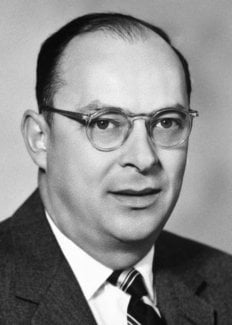John Bardeen
Biographical

John Bardeen was born in Madison, Wisconsin, on May 23, 1908, son of Dr. Charles R. Bardeen, and Althea Harmer. Dr. Bardeen was Professor of Anatomy, and Dean of the Medical School of the University of Wisconsin at Madison. After the death of Althea, when John was about twelve years old, Dr. Bardeen married Ruth Hames, now Mrs. Kenelm McCauley, of Milwaukee, Wisconsin.
John Bardeen attended the University High School at Madison for several years, but graduated from Madison Central High School in 1923. This was followed by a course in electrical engineering at the University of Wisconsin, in which much extra work was taken in mathematics and physics. After being out for a term while working in the engineering department of the Western Electric Company at Chicago, he graduated with a B.S. in Electrical Engineering in 1928. He continued on at Wisconsin as a graduate research assistant in electrical engineering for two years, working on mathematical problems in applied geophysics and on radiation from antennas. It was during this period that he got his first introduction to quantum theory from Professor J.H. Van Vleck.
Professor Leo J. Peters, under whom the research in geophysics was done, took a position at the Gulf Research Laboratories in Pittsburgh, Pennsylvania, and Bardeen followed him there and worked during the next three years (1930-1933) on the development of methods for the interpretation of magnetic and gravitational surveys. This was a stimulating period in which geophysical methods were first being applied to prospecting for oil.
Because he felt his interests were more in pure than in applied science, Bardeen resigned his position at Gulf in 1933 to take graduate work in mathematical physics at Princeton University. It was here under the leadership of Professor E.P. Wigner, that he first became interested in solid state physics. Before completing his thesis (on the theory of the work function of metals) he was offered a position as Junior Fellow of the Society of Fellows at Harvard University. He spent there the next three years, 1935-1938, working with Professors Van Vleck and Bridgman on problems in cohesion and electrical conduction in metals, and also did some work on level density of nuclei. The Ph.D. degree at Princeton was awarded in 1936.
From 1938-1941, Bardeen was an Assistant Professor of Physics at the University of Minnesota and from 1941-1945 a civilian physicist at the Naval Ordnance Laboratory in Washington, D.C. Work done during the war was on influence fields of ships for application to underwater ordnance and mine-sweeping. After the war, in late 1945, he joined the solid state research group at the Bell Telephone Laboratories, and remained there until 1951, when he was appointed Professor of Electrical Engineering and of Physics at the University of Illinois. Since 1959 he has also been a member of the Center for Advanced Study of the University.
Main fields of research since 1945 have been electrical conduction in semiconductors and metals, surface properties of semiconductors, theory of superconductivity, and diffusion of atoms in solids. In 1957, Bardeen and two colleagues, L.N. Cooper and J.R. Schrieffer, proposed the first successful explanation of superconductivity. Much of his research effort since that time has been devoted to further extensions and applications of the theory.
He is a Fellow of the American Physical Society, has been (1954-1957) a member of its Council, and on the Editorial Board of The Physical Review and Reviews of Modern Physics. From 1959-1962, he served as a member of the United States President’s Science Advisory Committee.
Bardeen was elected to the National Academy of Sciences in 1954. Honours include the Stuart Ballentine Medal of the Franklin Institute, Philadelphia (1952) and the John Scott Medal of the City of Philadelphia (1955), both awarded jointly with Dr. W.H. Brattain, the Buckley Prize of the American Physical Society (1955) and D.Sc. (Hon.) from Union College and from the University of Wisconsin. He received the Fritz London Award for work in low temperature physics in 1962.
Bardeen married Jane Maxwell in 1938. They have three children, James Maxwell, William Allen and Elizabeth Ann.
This autobiography/biography was written at the time of the award and first published in the book series Les Prix Nobel. It was later edited and republished in Nobel Lectures. To cite this document, always state the source as shown above.
John Bardeen was also awarded the Nobel Prize for Physics in 1972. He died on January 30, 1991.
Nobel Prizes and laureates
Six prizes were awarded for achievements that have conferred the greatest benefit to humankind. The 14 laureates' work and discoveries range from quantum tunnelling to promoting democratic rights.
See them all presented here.
